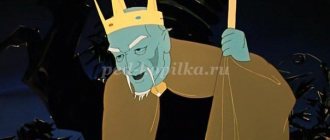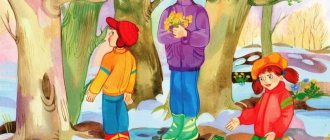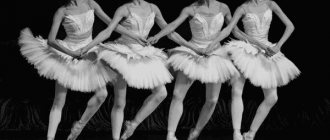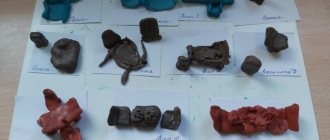Goal: to expand children’s ideas about the world of theater, about theatrical professions, to stimulate their interest in theatrical art, to enrich children’s vocabulary with theatrical terms.
Equipment: illustrations of the theater premises, theater poster, theater tickets, theater programs, slides with views of various theaters, photographs of actors, fragments of various performances, didactic game “Theater Professions,” dummies of vegetables and fruits, artificial flowers, attributes for the game “Barbershop.”
Educator: Do you know what theater is, what “theater art” means, what professions people work in the theater? (children’s answers).
Theater - the art of the stage - was born in ancient times. The word THEATER came to us from the Greek language and means “place for spectacle, spectacle.” But theater is not only an art form, but also a building where we come to performances.
Want to take a tour of the theater? (Illustrations of various theater buildings are exhibited).
Here is a house, big, beautiful, elegant, old. This is the theater building. Look, in front of him is a colorful, bright poster - a theater poster, which, using drawings, photographs and various words, contains information about upcoming performances in the theater (author of the play, director, actors who play the main roles, title, date and time of the performance). Let's go into this beautiful house. Where have we ended up? Look, we see a small window on which is written “Theater Box Office”.
Come to the window
Give him the money.
And a little window in response
Gives you a ticket.
A theater box office is a place where tickets for theater performances are sold. They contain the name of the theater, the name of the performance, its author, the date and beginning of the performance, as well as the place and row in the auditorium. A cashier sells tickets at the theater box office. Upon entering the theater, the ticket attendant checks the spectators' tickets. A theater performance usually takes a long time, more than an hour. It will be uncomfortable for spectators to sit in outerwear. What should I do? Where should viewers go first? (Children's answers). In the theater, the locker room is called a wardrobe, and the profession of the person who accepts the audience's outerwear is a cloakroom attendant. The cloakroom attendant gives you a number, you clean yourself up and move on.
Are you interested in knowing what today's performance will be about, what actors will play in it? Then you and I simply need to purchase a theater program from the theater employee, the usher. Look, it indicates the characters (heroes) of the play, as well as the names of the actors who play the roles of these characters. The program may also contain a brief description of the performance.
So, you and I are spectators. The performance will begin soon and it’s time for us to go to the auditorium. But what is it? Which of you is the most attentive and heard an unusual sound? This is a theatrical call. In total, the theater rings three bells before the start of the performance. The third bell indicates that the performance is beginning. After the third ring, the lights in the hall go out. It is indecent to enter the auditorium after the third bell. Before the third bell rings, let's take a closer look at the auditorium. This is the largest room of the theater. Take a closer look, do you like it? What makes an auditorium beautiful? (Walls, lamps, in the center of the ceiling there is a huge chandelier). Do you have chandeliers at home? Are they the same as this one? (Children's answers). This chandelier is very large, as the auditorium itself is huge. When the performance begins, this chandelier will go out, darkness will fall in the auditorium, and special spotlights will illuminate the stage. Soffits are special lamps in the auditorium that illuminate the stage from the front and above. With the help of spotlights, lighting designers can depict sunrise or sunset, flashes of lightning, starry skies and much more on stage.
Let's take our seats in the auditorium. How to do it? (See what is indicated on the ticket). The seat you should sit in is indicated on your theater ticket. Parterre - front, bottom rows, amphitheater - top, back. If you are sitting far from the stage, you will need theater binoculars, which you can bring with you or purchase from the cloakroom.
Let's take a look at our auditorium. The most important place in the auditorium is the stage on which the performance is performed. The scene itself is not yet visible. It is still closed with a curtain. A theater curtain is a piece of cloth that covers the stage from the audience. Curtains are made of thick, dyed fabric, folded and decorated with theater emblems or wide fringe sewn to the bottom of the curtain. The performance will begin as soon as the curtain rises or moves apart, as they are sliding or rising.
Many performances in theaters are accompanied by music. Where do you think the musicians sit, is it really on the stage? (Children's answers). The orchestra pit is a special room for the orchestra in the theater, located in front of the stage.
Before the audience can see the performance, people of different professions prepare it for a long time. Let's list them and try not to forget anyone! (Theater professions)
• The scenery for the performance is made in the painting and decoration workshop according to the sketches of the decorative artists.
• Prop - fake, specially made objects of sculpture, furniture, dishes, used in theatrical performances instead of real things. A theater worker who makes props is called a prop maker.
(The teacher shows the children fake things as examples: dummies of vegetables and fruits, artificial flowers, etc.).
• The sound for the performance - the phonogram - is prepared by the sound engineer. During the performance, he can turn on any soundtrack: the sound of rain or the roar of waves, the roar of the crowd or the whistle of the wind.
• Actors for a performance may need a variety of costumes: ancient and modern, fairy-tale and ordinary. The profession of a person who sews and makes suits is called a “costumer.”
• Before the performance, the make-up artist applies makeup to the actors. An experienced make-up artist can change an actor's face beyond recognition.
• The director chooses which play to stage, assigns roles, organizes and conducts rehearsals and everything that happens on stage.
• An actor is a person who plays a role in a play.
• A person who monitors the progress of the performance, the performance of the actors, and can, if necessary, suggest the words of the role to the actors - a prompter.
• A person who leads (conducts) an orchestra of musicians is called a conductor.
A didactic game “Theater Professions” is being held
Today our performance is on stage for the first time, so today is the premiere of this performance. So, the first act (part) of the play began.
(Children are invited to look at the illustrations of any children's performance or watch a video).
Are you tired, do you like our performance? The actors play wonderfully! Do you think they need to rest and prepare for the continuation of the performance?
(Children's answers)
The break between the actions of the play is called intermission. During intermission, all spectators usually go out into the theater foyer. At this time, you can go to the buffet, clean up in the toilet room, and also get acquainted with various photographs of theater artists that are hung on the walls of the foyer.
(Children look at photographs of Perm theater artists and excerpts from the performances in which they played).
Our performance has come to an end. Did you like him? How can we express this without words? Should I thank the actors for their wonderful performance? That's right, applause! Applause is a form of expressing gratitude to artists. If you liked the acting, give it a round of applause! You can also give them flowers.
Educator: We learned a lot of interesting things about the theater today. But there is a special place in it, which is called the mysterious word “backstage” - what is behind the stage. Today we were allowed to visit there with you. You can find a lot of interesting things here. The audience does not see this space. The actors and employees of the theater have their own entrance from the street, leading directly to the stage. Let's get acquainted with the premises of the “backstage kingdom”.
(The teacher lists these rooms and explains their purpose: decorator and props workshop, costume room, actors’ dressing room).
Educator: let us go into one of these rooms. Look, a table! Is he wearing a mirror, paints, powder, makeup, wigs? What kind of room is this? (Children's answers). That's right, this is the actors' dressing room. Let's now play actors and make-up artists, make princesses out of girls, and grandfathers out of boys.
(Children distribute the roles of make-up artists and actors among themselves and the transformations begin before everyone’s eyes)
The children then “return” back to kindergarten.
Summarizing:
Educator: What new did you learn? What surprised you the most? What did you remember? What new words did you meet, etc.
Introducing children to finger theater.
Summary of a lesson on theatrical activities “The Three Little Pigs” in the senior group.
Antropova Nina Ivanovna teacher, Secondary Educational Institution No. 3, kindergarten “Kolosok”, urban settlement. Bezenchuk, Samara region
Objectives: 1. Improve children’s ability to convey images of fairy tale characters.
- Develop fine motor skills of the hands and fingers in children, develop memory.
- Form friendly relationships.
- Enrichment of vocabulary.
Methods: Playful, creative, verbal.
Advertising message
Preliminary work: Reading a fairy tale, looking at illustrations, memorizing proverbs about friendship.
Equipment: Dolls for the fairy tale “The Three Little Pigs”, houses, table, screen.
Activation of the dictionary: Performance, screen, curtain, applause, finger theater.
Progress of the lesson:
Voss : Guys, today we came to our small theater. There are many dolls here, and they are all different. All the dolls are kind and love to play with children. Let's remember which theaters they came to us from.
Children : These dolls are from the puppet theater (point to the dolls of the puppet theater), these dolls are from the tabletop theater (point to the dolls of the tabletop theater).
Voss : Who can tell why the theater is called tabletop?
Children : Because all the dolls are located on the table! And the whole fairy tale takes place on the table.
Voss : Well done! Today I will introduce you to finger theater puppets. And this type of theater is called finger theater, because all the puppets are dressed on fingers.
I ring the bell and say: “Guys, do you hear? The bell rings - it calls you into the auditorium. Sit down on the chairs, the dolls are waiting for you.”
We'll go quietly, We'll find chairs in the hall. Top, top, let's go, let's go, We'll sit, we'll sit - we'll wait.
I ring the bell again as the children sit down in their chairs.
The children took their places.
Voss : Look how elegant the screen is in front of you, and behind the screen there are little artists. They want to show you a fairy tale. Now another bell will ring and the fairy tale will begin.
The bell rings.
Vos: For the curtain to open, you need to ask it, that is, clap your hands. And when the audience claps, it’s called applause!
The children applaud. The curtain on the screen opens.
Vos-l : The curtain opens, the fairy tale begins.
Once upon a time there were piglets, Three cheerful friendly brothers. In the summer they ran and played, They didn’t expect the cold at all. (pigs are dancing)
Soon autumn came, the Piglets warned: “Everyone needs to build houses: Winter will come to you soon.” (they are building their houses)
The younger one made his house out of straw under a pine tree. He put up a light roof and decided to spend the winter under it.
The middle one also did not doze: He assembled a house from branches. He thought in a hut in winter, to live in the cold times.
Well, the elder brother worked and, of course, was not lazy. He built a house from stones, so that he could live peacefully in it,
The wolf came to the clearing, found a house made of straw, blew hard - and all the straw flew away from the house.
The younger one immediately ran away, To the hut where the middle one was sleeping, The wolf decided to break the hut... I had to run to the older one.
The wolf saw the third house, but decided to forget about it. He ran straight into the forest, and didn’t remember the piglets.
The wolf didn’t come again, he avoided them.
This is where the fairy tale ends - well done to those who listened!
The curtain closes and the children applaud.
I get up from the table. And I conduct the conversation standing up.
Voss : Well, guys, did you like the fairy tale?
Do you also want to play with our dolls?
Children : Yes!
Question : In order for your dolls to walk as well as mine, you need to train your fingers. Shall we train them?
Children : yes!
(Finger gymnastics “A squirrel is sitting on a cart...”)
Request : Get your hands ready.
A squirrel sits on a cart, She sells nuts (claps her palms and hits each other with her fists alternately) to the little sister fox, Sparrow, titmouse, Thick-fifted Bear, Mustachioed Bunny (bend one finger at a time, starting with the big one) To whom in the goiter, To whom in the scarf, Who cares (alternating fists against each other).
Children act out a scene from a fairy tale.
Vos : Well done guys. Please tell me which theater we met today?
Children : Today we met the finger theater.
Voss : Why is it called that?
Children : Because the main characters in the play are the fingers.
Voss : Where are all the heroes of the fairy tale?
Children : The heroes of the fairy tale are on stage, behind a screen.
Voss : What needs to be done for the curtain to open?
Children : You have to applaud for the curtain to open.
Voss : And when should you applaud and why?
Children : We must applaud at the end of the performance to thank our artists.
Voss : Which artist did you like the most?
Children's answers...
Voss : What did this fairy tale teach us?
Children's answers...
Voss : That's right guys, you need to be friendly, live together and you should always help and help out a friend.




